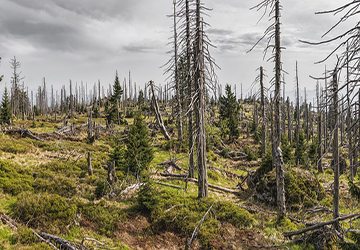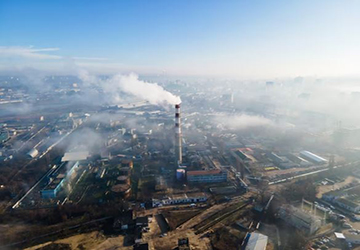Top 5 Global Environmental Issues
Our climate constantly changes and shows signs of severe weather conditions throughout different places. With the massive increase in natural disasters, such as various warming and cooling periods and out-of-season weather patterns, the need for awareness of environmental issues has grown.
Now the impact of these environmental issues might be severe, whereby a whole ecosystem vanishes. Or, it can provide water to once barren land, which in turn can create negative aspects on the biodiversity of that area. Whatever the reasons are, we need to address them on the right platform to get critical answers for protection.

Here is a complete list of the top 5 environmental issues that need urgent action.
1.Climate change and global warming
Climate change means changing weather patterns over a long period, and global warming results from these changing patterns. It happens with the increasing amount of greenhouse gasses being thrown into the air, causing damage to the ozone layer. The primary culprits are. Unfortunately, us humans causing pollution of all types, notably the burning of fossil fuels and deforestation.
Carbon dioxide is always one of the main culprits among other gasses that harm the atmosphere. All these gasses trap heat and lead to global warming, resulting in rising temperatures and melting glaciers, rising sea levels all around the globe, and extreme weather conditions.
All this also leads to coastal erosion and destruction of ecosystems. Whereby is a challenge for the agriculture industry and reserving freshwater resources.
2.Deforestation
The process of urbanization and clearing of forests to expand agriculture has dire consequences on the surrounding environment.
Deforestation also contributes to habitat loss. Additionally, it is threatening plants and species where some essentials have already gone extinct. It also affects water filtration and soil conservation. The cycle of deforestation leads to sudden climate change also. Many flash floods and floods are destroying areas and replacing humans and animals.
And to think of it, the deforested area is left barren if there is no afforestation program there, which means that the area becomes dry and useless in the end.
3.Air pollution
Various industries cause air pollution daily. It starts with transportation, heavy industry and manufacturing, mining, commercial buildings, the energy sector, and chemical industries, to name a few. They mainly emit nitrogen oxide, sulfur dioxide, and other lethal compounds causing air pollution.
Because of this emission, there are many health impacts as well. People now have respiratory problems, cardiac diseases, cancer, and premature deaths, to name a few. The harmful particles penetrate deep into the lungs causing collateral damage. There are Asthma and COPD on the rise too.
In addition, there is acid rain damaging soils, forests, and aquatic life. It can alter the diversity beyond repair.
4.Water pollution: preserving resources for the future
Water pollution happens when exterior contaminants enter the water bodies through various means. These contaminants' primary sources are industries, agricultural runoff, improper waste disposal from commercial and residential areas, and sewage discharge.
Various small-scale industries throw their waste in nearby lakes and water streams. It causes disruption and produces a foul smell turning fresh water into the dirt, and it strains the local community to purify and make it drinkable.
Do see that the current practice of throwing waste into water leads to the extinction of sea creatures essential for the sea cycle. Otherwise, everything will go to waste, and we could go extinct like dinosaurs.
5.Hazardous waste
Hazardous waste refers to materials that pose risks to human health and are considered toxic for humans and the environment. It includes flammable substances, harmful chemicals, and radioactive materials used by the energy sector. Since there is no careful disposal, the industries dump them into water or nearby ground.
But the problem is that this hazardous waste has irreversible impacts. Besides, it is damaging the ecosystem gravely and contributing a lot to air pollution.

Addressing environmental issues
Addressing environmental issues is a multifaceted task that requires governments, communities, and individuals to work together. Here are some steps you can take to address the problems.
1.Raise awareness
The first step is to educate others and yourself about the environmental challenges. Many are in denial and continue their practices which can become a threat at any time. Tell people about climate change, deforestation, biodiversity, and climate change through social media, campaigns, local events, and workshops.
2.Recycle
Reduce, reuse, and recycle to minimize waste generation. We all can reduce the consumption of angle-use items and resume all materials whenever possible. You can alter the products into something new for fashion. With that, a proper waste management system will come in handy too.
3.Conserve energy
Become an energy-saving person immediately. Close all lights, fans, and other electronic items when you are leaving the room or if they are not in use. Choose renewable energy resources wherever possible. With that, use less water, fix leaks, take short showers, and use water-saving devices.
4.Sustainable transportation
Opt for carpooling for work and family vacations. The best option is to take a cycle or walk, and it will reduce carbon emissions. If you ever need to use a vehicle, buy a hybrid or electric one.
5.Renewable energy
Many families and small-scale industries are going off-grid these days. They use solar panels or live near hydro plants to generate electricity and run appliances and devices when necessary. Similarly, the government must create wind farms for the same purpose. Our policymakers must keep a budget for this in their agenda.
6.Plant trees
Green areas are highly essential for us, and we all must plant trees as they absorb carbon dioxide. The government must initiate reforestation projects and educate people to plant trees and other plants wherever possible.
7.Fewer chemicals
Reduce the use of chemicals in industries, commercial and residential places. The toxic fumes are not environmentally friendly and pose a danger to humans by contributing to the spread of various fatal diseases. For this, properly dispose of waste at designated places only.
8.Change policies
Changing policies is detrimental subject to climate change. If there are rules and regulations, organizations and regulations can only run awareness campaigns or promote advice to save the environment. In addition, they place heavy fines on anyone who breaks the law for the encouragement of others.
9.Lead by example
Become a role model for sustainable practices. Show through your actions and alter your lifestyle and work habits that change is possible. Also, share your knowledge with others. Also, start educational programs because students are the next generation who can become responsible if we train them right.
Remember, change takes time, but it is possible. Do not give up hope and show through your small changes that, collectively, we can make a difference. Encourage others to join you on this journey.










